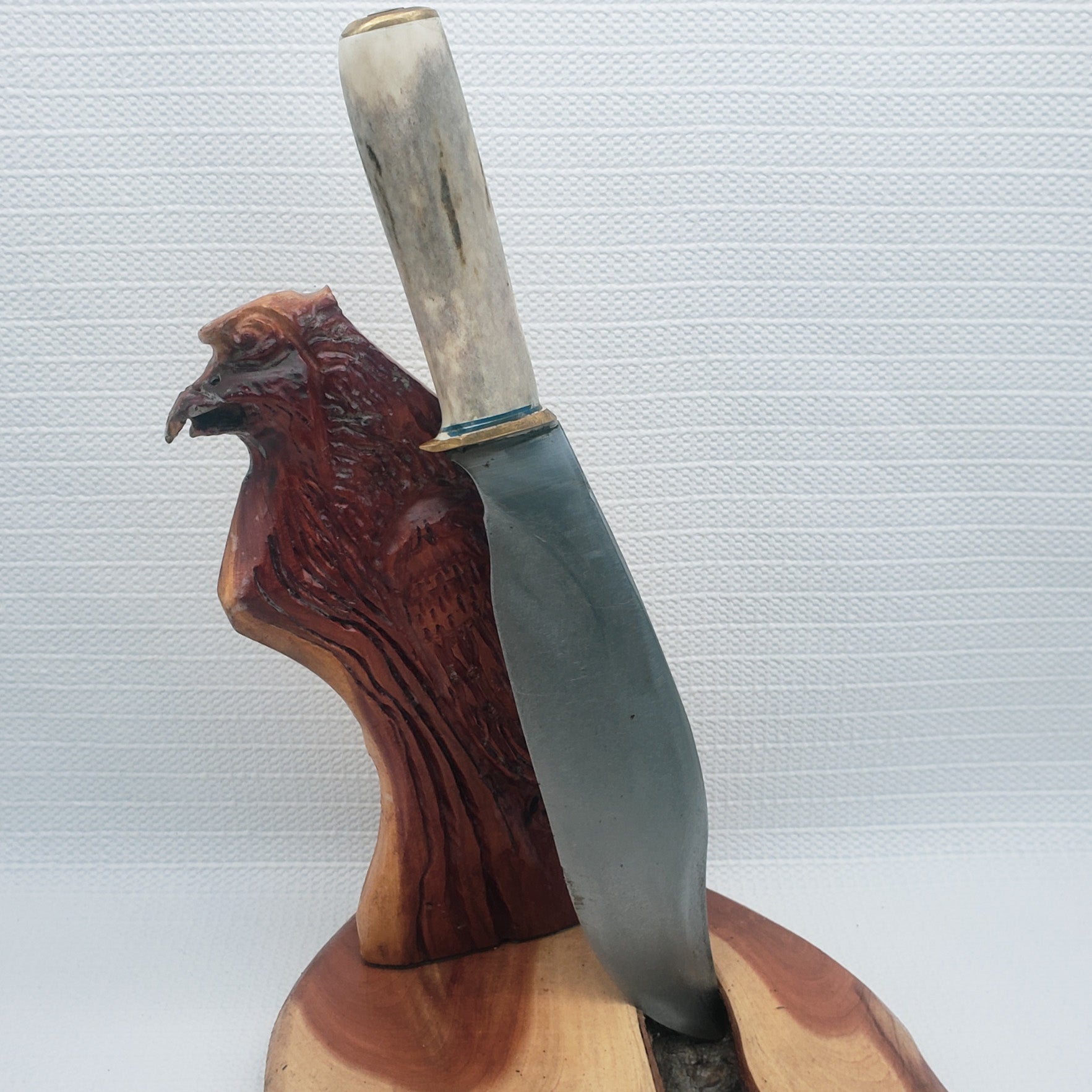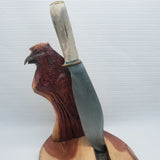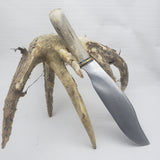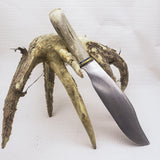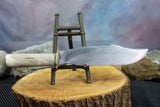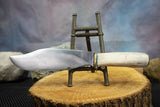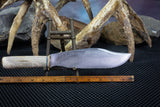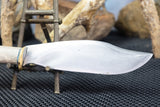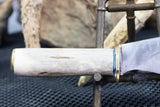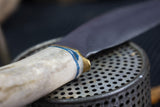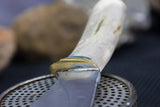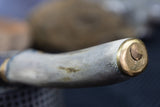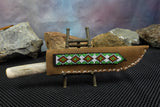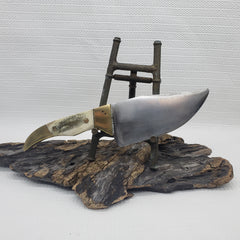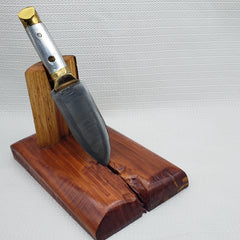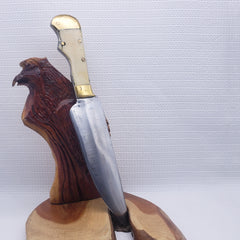Roach Belly Knife 1810 to 1820 Little Badger Handcrafted
Little Badger
Orders over $50. Details
Our Knife:
This is a Little Badger design Roach Belly Knife from the middle 1810’s. He has used the classic lines patterned after actual Roach Belly knives.
This Roach Belly is a fairly large knife at 11.5” long. The traditional clip point blade is 7.5” long. Comes with handcrafted hone bezil and edge, and very sharp. The blade itself is made from hand forged Amalgamated steel, all carbon, forged into hardened steel on Badger’s self made forge.. Handle is a superb polished white tail deerAntler.
.The tang on this knife is round and goes up the antler at least ¾ down the shaft. Strong bond and It aint coming off. Those guys in 1830 did not have the epoxies we have now. The epoxy used to secure this knife made a chemical welded bond between the tang and the antler. The tang and the antler will never separate, they are one.
There is a finger groove technically called the ricassa and choil. This is the non sharp part of the knife between the edge and the hilt. This groove has several functions. The groove is an excellent holding place for the fore finger. Use this groove for sharpening balance, and works well for hand to hand combat as well with butchering and skinning.
The Bolster/qullion is made from traditional brass. Brass was easy to get and worked well with these knives. This brass Qullion gives this knife a unique look that you won’t see very often in modern historical replicas.
The sheath is stitched together with a Metis whip stitch, Badger learned from his Grandfather. The traditional seed bead work is Badgers wife’s, Talking Bird, art, also a Metis tribal member. Talking bird uses her own unique stitch, always with a flaw. This flaw cannot be replicated by machinery and traditionally teaches us that we and everything is flawed. Nobody is perfect. talking bird with her own unique pattern.
Carbon blades are known for their patina… and rusting without oiling. Forging a carbon blade is an art. The blade needs to be taken care of with a light coat of oil regularly. I oil my blades weekly with machine oil like a 3 in 1. I emphasize weekly to get that beautiful blue Patina these old blades were known for. That is why so many modern blades are made from a form of stainless steel. Stainless blades are hard to keep sharp but they do not rust. There is not much work involved in a stainless blade but the regular sharpening process because they do not hold an edge. Carbon blades hold an edge and are stronger and more versatile.
Little Badger Knives are made using the same techniques and styles of the original frontiersman knives of the 1820’s thru 1880’s. Very few of those men used a mass produced knife. They were forged by the local blacksmith. Each knife was an individual piece.
Badger knives are made in the same tradition. Each knife is unique, no two knives are the same. I ship knives, well oiled, wrapped in plastic wrap. Do not touch the blade. Touching the blade of a newly forged carbon blade can leave permanent prints from the oil in our skin. I never touch the blade with my skin. I always use fine cloth. When you get your knife Wipe the oil on the knife and re oil. It only takes a couple drops. Oil weekly and you will build a beautiful blue patina on the blade.
*Authentic Native American Knives
As a member of the state-recognized tribe, Cherokees of Northeast Alabama, Keith Little Badger is in full compliance with The Indian Arts and Crafts Act of 1990. This Act protects Native American Artisans. All products must be marketed truthfully regarding Indian heritage and tribal affiliation of the producers.
Roach Belly History:
The "Roach Belly" shape of the blade easily dates back to the 18th Century and was a very popular style blade across the Americas, considered a blade for many purposes. The "Roach Belly", with its curved cutting edge, was sold by most North American fur trading companies in the 1600’s through the Early 19th centuries. A typical English kitchen knife of the period, These knives were often used as Rifleman knives especially from around 1800 through 1820. The Roach Belly is a precursor to the Bowi knife of the 1830’s.
These knives were used as a versatile knife being a weapon, a camp knife and a butcher knife. These particular style knives also would double as a scalping knife.
Why buy from Extremely-Sharp:
-
Awesome Selection of Knives & Swords in Stock: We carry an incredible secltion of knives and swords from the best brands. Plus, we always have something new.
- Personalized Customer Service: We know what we sell because everyone on our team uses our products. Call or email us and get a real person, if not the owner.
- 100% protected and secured: We care about security as much as you do. Everything on our site is secure and we ship fast.
-
Family Owned: We' re owned and run by family and our goal is simple - we want you to feel like family too. Started by two brothers in 1997, our family has grown and has our site. The biggest growth is still from friends telling friends. 18+ years selling knives online with 25,000+ customers and mentions on HGTV, Wired and others...we're on the right track.
- Small Business Values: You' ll still find our founder One Arm Don answering phone calls and replying to emails. Plus, did you know? For every $100 spent at a local or family business, $68 returns to the community. Buying from us keeps the community growing, and not some big corporation.
- We love knives and swords: While we do have a few highly skilled weaponry experts (extensive training in Goju Ryu Karate, Kenpo, Tae Kwon Do and various military disciplines), most of our team simply uses our products in their normal activities: camping, hiking, fishing, carrying for self defense, displaying in their home or office, etc. We' ve been blessed to be featured by HGTV and some incredible blogs. Let us know if you have a blog, site or might make an awesome prostaff team member.

